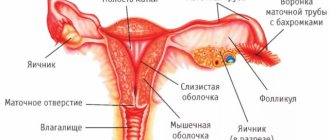How does air get in?
The vagina is a hollow organ that interacts with the external environment, like the mouth or anus. A person breathes, speaks, puffs out his cheeks and the air, without causing embarrassment, enters his mouth. Air enters the anus from the intestines, getting inside when talking or eating food, and its subsequent assimilation. As people age, they learn to control the release of gas by controlling the contractions of the sphincter. Air enters the vagina from the external environment; this is natural and does not deserve complexes.
The only reason why air enters the vagina from the intestines is because of vaginal fistulas. Through fistulas, pathological anastomosis, the contents of the urinary tract and intestines (gases, feces, urine) enter the vagina. To establish a diagnosis, a thorough examination in gynecology is performed.
What else can you do if your vagina “farts”?
You can prevent air from leaving the vagina during sexual intercourse in the following ways:
- If the problem could be caused by excessive vaginal dryness, then solving it is quite simple; for this it is recommended to use special lubricants that contain estrogen. They should be placed directly into the vagina several hours before sexual intercourse so that the body has time to prepare.
- Currently, special vaginal applications aimed at eliminating vaginal flatulence can be purchased in pharmacies.
- Surgical intervention is a last resort and is performed only when indicated, for example, in the case of vaginal prolapse or the presence of a fistula. In this case, the surgeon fixes the reproductive organs in the correct position or eliminates the passage between the vagina and intestines, which makes it possible to cope with the problem of flatulence.
Reason for queefing during sex
Anatomically, the vagina looks like an elastic tube through which fertilization occurs at the end of sexual intercourse, and subsequently childbirth. When a woman is aroused, part of the tubular formation, near the cervix, forms an extension to collect sperm at the moment of ejaculation. With the characteristic piston movement of the penis, air is pumped into the expansion using a pump effect. This happens without attracting the attention of partners and does not cause discomfort until, with a spasm of the vaginal muscles, air comes out of the hole, accompanied by a piquant sound.
Some sex positions favor the penetration of air into the vagina: knee-elbow, doggy style. The woman stands or sits on all fours, and the man inserts his penis from behind. The low position of the partner's body increases the likelihood of the formation of an air space, as does the frequent change of positions, loved by men.
Vaginal fistulas (fistulas) and gases
Fistulas or fistulas occur when abnormal openings develop between two organs that should not anatomically be connected to each other. In particular, they can occur at times when scar tissue forms or disappears. Vaginal fistulas can cause vaginal gas.
Fistulas can develop between the vagina and other pelvic organs. The symptoms associated with fistulas depend on their size, location, and the organs affected.
Possible types of vaginal or vaginal fistulas include the following.
Vesicovaginal fistula
Vesicovaginal fistula (vesicovaginal fistula) is characterized by the development of communication between the vagina and the bladder.
At least three million women in developing countries have unresolved vesicovaginal fistulas. This condition is usually associated with complicated childbirth and injuries received during gynecological operations.
In developed countries, vesicovaginal fistulas are less common, although they still occur in 3-5% of cases of cancer of the vagina, cervix and uterus (endometrium).
The most common symptoms of vesicovaginal fistulas are abnormal watery discharge and regular urine leakage. Large fistulas can cause pain and discomfort.
Uretero-vaginal fistula
A ureterovaginal fistula (uretero-vaginal fistula) occurs when a connection develops between the vagina and the ureter, a tubular structure that is usually located on both sides of the body and connects both kidneys to the bladder to further remove urine from the body.
Most uretero-vaginal fistulas result from injuries sustained during gynecological surgery, such as hysterectomy.
The most common symptoms of ureterovaginal fistulas are urine leakage from the vagina and abdominal discomfort.
Urethrovaginal fistula
A urethrovaginal fistula (urethrovaginal fistula) results from the development of an opening between the vagina and the urethra (urethra), a tube-like structure that connects the bladder to the outside of the body.
The most common symptom of a urethrovaginal fistula is regular leakage of urine from the vagina, which increases with pressure on the abdominal cavity.
Enterovaginal fistula
An enterovaginal fistula (colovaginal or enterovaginal fistula) develops when an abnormal communication forms between the vagina and the small intestine.
This condition may result from abdominal and pelvic surgery or inflammatory bowel disease (IBD) such as Crohn's disease.
Symptoms of enterovaginal fistulas include abdominal pain and gas passing through the vagina.
Rectovaginal fistula
A rectovaginal fistula (rectovaginal fistula) forms when an abnormal connection between the vagina and rectum develops.
This condition can have several causes, including:
- inflammatory bowel diseases, such as Crohn's disease or ulcerative colitis;
- prolonged or difficult labor;
- injuries during surgical procedures or postoperative complications such as infections;
- radiation (radiation) therapy of the pelvic organs;
- cancerous tumors.
The most common symptoms of a rectovaginal fistula are inflammation, gas or feces passing through the vagina, and a foul odor.
Colovaginal fistula
Colovaginal fistula (colic-vaginal fistula) is characterized by the development of an opening between the vagina and the colon.
This condition is rare and usually results from complications following pelvic surgery, including hysterectomy. Colovaginal fistula can also occur due to gastrointestinal diseases such as diverticulitis, Crohn's disease or ulcerative colitis.
The most common symptoms of a covaginal fistula include:
- passage or leakage of gas or feces through the vagina;
- foul-smelling vaginal discharge that may not be colored;
- numerous recurrent infections of the vagina and urinary tract;
- pain and inflammation in the area between the vagina, colon, and outer vaginal tissues during sexual activity.
After childbirth
Air entering the vagina after childbirth occurs due to weak and stretched pelvic floor muscles, located between the pelvic bones, in the form of ligamentous and muscular structures. During the birth process, the baby moves along the birth canal, the openings expand under the pressure of the fetus, and then return to their previous position.
If the baby moves too quickly towards the exit, and the woman’s body has not had time to prepare the ligaments, or the fetus is large, then a traumatic outcome is possible in the form of damage to the pelvic floor muscles. Tears occur, or the obstetrician, helping the woman in labor, decides on the need for perineotomy or ipisiotomy, in simple words - makes incisions. Often, after such an operation, only the skin of the perineum is stitched, and the muscles remain unchanged.
Treatment of prolapse and loss of internal genital organs
If the defects of the supporting structures are minor and the internal genital organs do not fall below the plane of the vaginal opening when straining (usually there are no complaints), treatment is not carried out.
The exception is patients with stress urinary incontinence who are scheduled for surgical treatment. In other cases, the treatment tactics for prolapse and prolapse of the internal genital organs are determined individually. It can be conservative (use of uterine rings made of synthetic material) or surgical. Uterine rings are installed in the vagina if there are contraindications for surgical treatment (for example, concomitant somatic pathology of various organs and systems - heart, lungs, kidneys, etc., elderly patient). They can be silicone and remain in the vagina for several months. Other uterine rings, which are often made of rubber, should be removed by patients at night to prevent bedsores (death of tissue as a result of constant pressure of the ring on the vaginal walls). After selecting the uterine ring, the patient is taught to insert and remove it independently. The frequency of examination of such patients is determined individually, usually the first examination is carried out after a week, and then, in the absence of complaints, every 4-6 months.
If the defects of the supporting structures are minor, no treatment is performed.
A radical solution to the problem of genital prolapse is surgical treatment. The purpose of the operation is to permanently eliminate all defects in the supporting structures. Many operations have been developed to pursue this goal. Typically these operations are performed through the vagina.
Hysteropexy (fixation of the uterus to something) is performed for women planning to have children in the future, if conservative treatment is ineffective. The best treatment results are obtained by fixing the uterus to the anterior longitudinal ligament of the sacrum, and the uterosacral ligaments are sutured to the sacrum not directly, but using a synthetic mesh or a section of fascia.
If the vaginal walls prolapse, colporrhaphy and perineoplasty are performed - an operation that consists of excision of “excess tissue” and strengthening of the perineal muscles by suturing their legs. Women who have undergone colporrhaphy undergo a cesarean section in the event of a subsequent pregnancy.
If a woman has urinary incontinence, without genital prolapse, then a method such as plastic surgery with a free synthetic loop - TVT/TVT-O - can be used. The intervention eliminates an unpleasant symptom (urinary incontinence), but does not eliminate prolapse of the vaginal walls. The operation lasts 20-30 minutes under local anesthesia. During this operation, the doctor passes a special tape made of synthetic polypropylene material under the urethra through three small incisions in the suprapubic area. The tape supports the urethra and prevents involuntary urination when intra-abdominal pressure increases. The surgeon checks the effectiveness of the intervention directly during the operation. The patient is asked to perform several coughing movements, and if no urine leakage occurs, then the operation is completed. If necessary, the doctor changes the tension of the loop.
In cases of complete uterine prolapse in old age, vaginal hysterectomy is performed (i.e. complete removal of the uterus through the vagina). During this operation, anterior or posterior vaginal plastic surgery, correction of intestinal hernia, etc. can be performed simultaneously from the same access.
Vaginal flatulence after menopause
Menopause occurs in women around the age of fifty. This is a natural process that means a decline in reproductive function. The ovaries malfunction, estrogen synthesis decreases. Lack of the hormone causes the tone of the vaginal muscles, the elasticity of the walls gradually decreases, and dryness of the vaginal mucosa occurs. It is dryness in the vagina that is the main cause of vaginal flatulence in older women.
The period of menopause is due to the following symptoms:
- increased body temperature;
- depression;
- withering of the skin;
- frequent urination;
- increased blood pressure;
- irritability;
- decreased libido.
Possible solutions to the problem
To strengthen the muscle tissue of the vagina, a number of highly targeted exercises are recommended:
- Kegel exercise;
- deep squats;
- use of vaginal simulators;
- wumbling (intimate gymnastics).
These exercises will help prepare the birth canal for the upcoming test and will speed up the restoration of the tone of the pelvic floor muscles after the birth of the child. Classes are necessary to solve a specific problem of air in the vagina, and to improve the quality of sexual life and increase libido.
If the mucous membrane of the intimate womb is dry, there is a high probability of a positive effect from taking herbal remedies containing the hormone estrogen. Intravaginal applications with estrogen, or suppositories, perform the function of moisturizing the mucous membrane well.
Note! Medications are prescribed after a full medical examination, anamnesis is taken by a specialist.
Kegel exercise
Obstetrician-gynecologist Arnold Kegel developed a special exercise designed to strengthen the tone of the pelvic floor muscles. You can do it anywhere without attracting the attention of others. Technique for performing Kegel exercises:
- Squeeze the vaginal muscles and, as it were, pull them up for 10 seconds.
- Slowly relax your muscles for 10 seconds.
- Repeat the cycle 5-6 times 3 times a day.
Wumbuilding (intimate gymnastics)
Vumbuilding includes an extensive list of exercises, the main goal of which is to learn to feel each muscle separately, control it in isolation, leaving others in a relaxed state. Classes can also be performed at home (technique):
- Lie on your back, legs bent, feet shoulder-width apart, arms along your body. Squeeze your vaginal muscles for a few seconds, leaving your stomach relaxed. Continue the exercise for 5-6 minutes, gradually increasing the pace. Add push-out contractions.
- In the same starting position, alternate between pulling in and pushing out the anus muscles, leaving the abs and buttocks relaxed.
- Try to alternate tension of the muscles of the vagina and anus, trying to clearly feel the boundaries of the organs, not forgetting to make sure that the stomach is relaxed.
Stages of descent
To many of us, this seems like the highest degree of injustice: when giving life to a new little man, a woman is sometimes forced to pay a rather high price. Of course, compared to the happiness received in return, it does not seem so high. But why did the prolapse of the uterus after childbirth affect me specifically? After all, not everyone faces such trouble...
In fact, uterine prolapse after childbirth is quite common (the number of cases increases with age) and has its own physiological causes:
- injuries and ruptures during childbirth;
- heavy physical labor in the postpartum period;
- weakness of the abdominal muscles;
- violation of the natural position of the uterus;
- excessive stretching of the ligaments holding the uterus;
- congenital connective tissue deficiency.
The development of prolapse is provoked by a sharp decrease in estrogen in a woman’s blood, which is observed during the postmenopausal period. Stretching and weakening of the pelvic muscles is facilitated by repeated and difficult childbirth, carrying a large fetus or several children (multiple pregnancy), as well as chronic inflammatory processes in the pelvic organs, which are accompanied by deterioration of blood circulation in the tissues, including muscles and ligaments.
In the later stages of the disease, a woman feels discomfort and difficulty walking. When the cervix begins to fall out, it seems as if there is something in the perineal area that is in the way or something extra (like a foreign body).
Uterine prolapse of any degree, even at a very early stage, can be diagnosed by a gynecologist during an examination.
Prolapse of the uterus after childbirth causes a lot of trouble. In addition to disturbing pain, a woman experiences difficulties in sexual relations. As prolapse develops, all other organs may be involved in the process: prolapse (and even prolapse of individual organs) of the intestine, rectal loop, kidneys, bladder, vaginal walls occurs, since all of them, together with the uterus, are directly connected to each other. With uterine prolapse, there is a very high risk of developing infectious inflammatory processes in the organs of the genitourinary system.
In the early stages, uterine prolapse is treated conservatively with the help of special gymnastic exercises, physical procedures and water therapy. Kegel exercises are very effective in preventing and treating such complications.
If necessary, a gynecological pessary can be installed: a ring of safe flexible material that will mechanically hold the uterus in place.
If uterine prolapse is observed, surgical treatment is indispensable. For a woman who does not plan to give birth again, it is recommended to remove the uterus while preserving the appendages. If she is planning a pregnancy in the future, then during the operation the uterus is supported and kept in a fixed state (uterine prosthesis is performed).
Uterine prolapse is a deformation of the pelvic floor muscles and ligaments of the organ, changing its location in relation to the nearby bladder, rectum, ovaries, and appendages. The normal anatomical position of the uterus is the middle of the pelvic cavity, the organ is held by the muscles of the perineum and ligaments.
When it is pathologically displaced, the bladder and rectum are subjected to additional pressure, resulting in disruptions in their functioning. Prolapse is characterized by prolapse of the uterine fundus. First, the neck of the organ descends along the walls of the vagina, and then the organ itself. With complete prolapse, the woman feels it in the vagina, a small pouch is visually noticeable on the outside of the genitals. The photo shows what the pathology looks like.
Experts identify the following stages of the pathological process of uterine prolapse:
- The uterus moves into the vagina (towards the front wall, sometimes the organ is located higher). A woman experiences unpleasant sensations, reminiscent of menstrual pain, in the lower abdomen, while intimate relationships are painless. Over time, disruptions in the cycle begin.
- The cervix has dropped to the level of the vaginal outlet. The pain syndrome intensifies, accompanying intimacy. A characteristic symptom is the feeling of the presence of a foreign object inside the vagina.
- Loss of part of an organ from the genital slit. Characterized by bloody spots in the discharge, uncontrolled urination, severe pain (especially when changing body position).
- The organ falls out completely. This stage is considered the most difficult - it is impossible to sit or walk.











